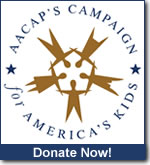No. 36; Updated December 2008
Click here to download and print a PDF version of this document.
A catastrophe such as an earthquake, hurricane, tornado, fire, flood, or violent acts is frightening to children and adults alike. Talking about the event with children can decrease their fear. It is important to explain the event in words the child can understand, and at a level of detail that will not overwhelm them.
Several factors affect a child's response to a disaster. The way children see and understand their parents' responses are very important. Children are aware of their parents' worries most of the time, but they are particularly sensitive during a crisis. Parents should admit their concerns to their children, and also stress their abilities to cope with the disaster. Falsely minimizing the danger will not end a child's concerns.
A child's reaction also depends on how much destruction and/or death he or she sees during and after the disaster. If a friend or family member has been killed or seriously injured, or if the child's school or home has been severely damaged, there is a greater chance that the child will experience difficulties.
A child's age affects how the child will respond to the disaster. For example, six-year-olds may show their worries by refusing to attend school, whereas adolescents may minimize their concerns, but argue more with parents and show a decline in school performance.
Following a disaster, people may develop Posttraumatic Stress Disorder (PTSD), which is a set of symptoms that can result from experiencing, witnessing, or participating in an overwhelmingly traumatic (frightening) event. Children with this disorder have repeated episodes in which they re-experience the traumatic event. Children often relive the trauma through repetitive play. In young children, upsetting dreams of the traumatic event may change into nightmares of monsters, of rescuing others, or of threats to self or others. PTSD rarely appears during the trauma itself. Though its symptoms can occur soon after the event, the disorder often surfaces several months or even years later.
After a disaster, parents should be alert to these changes in a child's behavior:
- Refusal to return to school and "clinging" behavior, including shadowing the mother or father around the house
- Persistent fears related to the catastrophe (such as fears about being permanently separated from parents)
- Sleep disturbances such as nightmares, screaming during sleep and bedwetting, persisting more than several days after the event
- Loss of concentration and irritability
- Jumpiness or being startled easily
- Behavior problems, for example, misbehaving in school or at home in ways that are not typical for the child
- Physical complaints (stomachaches, headaches, dizziness) for which a physical cause cannot be found
- Withdrawal from family and friends, sadness, listlessness, decreased activity, and preoccupation with the events of the disaster
For more information see Facts for Families:
#4 The Depressed Child
#8 Children and Grief
#34 Children's Sleep Problems
#66 Helping Teenagers with Stress
#70 Posttraumatic Stress Disorder
#87 Talking to Children About Terrorism and War
| Disaster and Trauma The Effects of Disaster on Children and Adolescents Allan K. Chrisman, M.D. Associate Professor of Psychiatry Program Training Director- Duke University Hospital Child & Adolescent Residency Training Program Division of Child & Adolescent Psychiatry Department of Psychiatry & Behavioral Sciences Duke University School of Medicine (2008) Disclosures duration: 00:35 |
| Definition of a Disaster Allan K. Chrisman, M.D. Associate Professor of Psychiatry Program Training Director- Duke University Hospital Child & Adolescent Residency Training Program Division of Child & Adolescent Psychiatry Department of Psychiatry & Behavioral Sciences Duke University School of Medicine (2008) Disclosures duration: 01:02 |
|
| How Parents can Lessen the Impact of Disaster on Kids Allan K. Chrisman, M.D. Associate Professor of Psychiatry Program Training Director- Duke University Hospital Child & Adolescent Residency Training Program Division of Child & Adolescent Psychiatry Department of Psychiatry & Behavioral Sciences Duke University School of Medicine (2008) Disclosures duration: 01:57 |
 See also: Your Child (1998 Harper Collins) / Your Adolescent (1999 Harper Collins)
See also: Your Child (1998 Harper Collins) / Your Adolescent (1999 Harper Collins)
Click here to order Your Child from Harper Collins
Click here to order Your Adolescent from Harper Collins
The American Academy of Child and Adolescent Psychiatry (AACAP) represents over 8,500 child and adolescent psychiatrists who are physicians with at least five years of additional training beyond medical school in general (adult) and child and adolescent psychiatry.
Facts for Families© information sheets are developed, owned and distributed by AACAP. Hard copies of Facts sheets may be reproduced for personal or educational use without written permission, but cannot be included in material presented for sale or profit. All Facts can be viewed and printed from the AACAP website (www.aacap.org). Facts sheets may not be reproduced, duplicated or posted on any other website without written consent from AACAP. Organizations are permitted to create links to AACAP's website and specific Facts sheets. For all questions please contact the AACAP Communications & Marketing Coordinator, ext. 154.
If you need immediate assistance, please dial 911.
Copyright © 2012 by the American Academy of Child and Adolescent Psychiatry.










